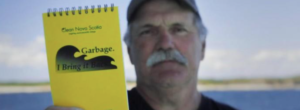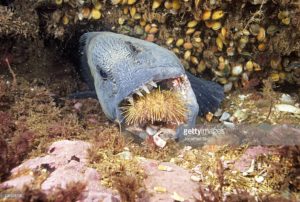Marine Waste Management
Background
With over 16,000 kilometers of coastline, it is no surprise that Newfoundland and Labrador has been built along the coast, with many communities relying year after year on the ocean for their livelihood. Due to this connection to the ocean, our province has the highest number of active harbours in the country, with 343 active harbours (the second highest is Nova Scotia with 226). Unfortunately, Newfoundland and Labrador’s marine environments experience various threats daily, including threats presented by marine debris.
Ship to Shore Program
In consultation and partnership with the Clean Foundation of Nova 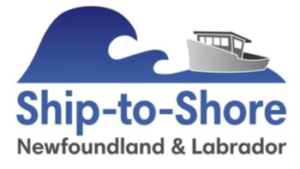 Scotia, the founders of the award winning Ship to Shore program, CPAWS-NL were thrilled to take the Ship to Shore program toNewfoundland and Labrador (NL)
Scotia, the founders of the award winning Ship to Shore program, CPAWS-NL were thrilled to take the Ship to Shore program toNewfoundland and Labrador (NL)
But what is Ship to Shore?
Through working with fish harvesters, marine vessel operators and harbour management, this program aims to reduce marine debris and encourage all ocean users to bring all of their waste back to shore and dispose of it properly. We aim to work with the communities and mitigate waste disposal issues, and find solutions to make the community a clean space both for its people and species it calls home. Identifying barriers that inhibit proper waste disposal will help reduce the amount of waste in our oceans and along our diverse coastlines.
Participating Communities in NL:
Since starting the program in 2017, we have brought the Ship to Shore program to different regions of the province. For each region, we had the opportunity to meet with many community members including ocean users, fish harvesters, marine vessel operators, and harbour management. We also had the pleasure of delivering presentations to students to talk all about marine debris. Many volunteers also participated in our beach and underwater cleanups, helping to reduce waste in the ocean. Apart from the participating NL communities highlighted below, CPAWS-NL has also organized cleanups in other areas of the province including Flatrock, Harbour Grace, Harbour Main, Portugal Cove-St. Philip’s, and Torbay.
Petty Harbour (2017)
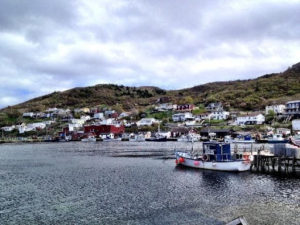
In 2017, the Ship to Shore Pilot Project was done in Petty Harbour. This small community is located on the eastern shore of the Avalon Peninsula of Newfoundland and has an active fishing industry. It’s also a well-known tourist destination with its very own Mini Aquarium that highlights marine conservation and local marine life.
What is Marine Debris?
Marine debris is any solid micro or macro waste that is intentionally or unintentionally disposed of or abandoned in the marine environment. It includes all kinds of plastic, metal containers, waste oil and other man-made materials. Marine debris damages habitat, kills wildlife through entanglements, ingestion, injuries, and ghost fishing, deters tourists, threatens human health and is a hazard for navigation and fishing gear. To secure our marine resources, we must ensure the health of its ecosystems. The density and distribution of marine debris originating from human activities are primarily governed by the amount of ocean industry and shipping traffic, the proximity to populated coastal areas, and the patterns of oceanic circulation and surface winds. Discarded and lost fishing gear and other debris from fishing vessels are most noted as the dominant components of marine debris.
It’s important to report large marine debris hazards such as equipment used within the ocean industry such as netting. If you know of hazardous large marine debris that is difficult or unsafe to retrieve
Why Involve Fishers and Harbour Authorities?
Discarded and lost fishing gear, and other debris from fishing vessels, are the most common and visible forms of marine debris, where 80% of ocean plastics are related to fishing activities. Therefore, the key to minimizing marine debris in the ocean is to listen to the concerns of regular ocean users – those who know their waters the best, and guide them into effective change.
CPAWS-NL envisions a clean, healthy environment not only to aide the ecosystem but to ensure the longevity of sustainable resources.
What Can You Do?
What Can You Do?
-
Return all waste used at sea back to shore, disposing, recycling or reusing items properly. Litter on land can also end up on the oceans by wind and water runoff.
-
Reduce plastic use – as many ocean species such as whales and turtles mistake plastics for food. Plastic and other debris can not be naturally expelled from the body.
-
Ensure all fishing gear such as fishing lines, gears, ropes, nets, are not released at sea, as these can cause entanglements in whales and turtles, and become ghost nets on the ocean floor. Report any and all fishing gear that can not be safely retrieved to DFO or CPAWS-NL
-
TAKE THE OCEAN CHAMPION PLEDGE!
Effects of marine debris on species at risk
Leatherback Sea Turtle
It may be hard to believe, but Newfoundland and Labrador is home to a turtle! The Leatherback Sea Turtle are migrating species, and like whales, they travel along our coasts throughout summer to forage before returning south to breed. Atlantic Canada has a predictable abundance of jellyfish, and therefore hosts one of the highest densities of foraging Leatherback Sea Turtles. Unfortunately for human viewing, Leatherbacks will never be found onshore in Newfoundland, as they stay out in the ocean snacking on jellies!
Leatherback Sea Turtles is 1 of only 7 species of marine turtles in the world. As per their name, they have a leathery shell, differing from the “typical” bony shells of other species of turtles (including the other 6 marine species). The shell is shaped like a teardrop with 7 distinct dorsal ridges tapering at the tail. Leatherback Sea Turtles are bluish-black in colour with scattered white blotches and have very large paddle-shaped front flippers. Each adult has a uniquely patterned “pink spot” on the top of the head, which is believed to play a role in prompting migration by responding to seasonal changes in daylight. The adult Atlantic population of Leatherback Sea Turtles that frequent our waters have an average curved carapace (shell) length of approximately 1.5 metres and an average weight of approximately 400 kg. As their diet consists mainly of jellyfish, the throat and the esophagus of Leatherbacks are covered with spines which is an adaptation to assist in swallowing the slippery jellies.
Dermochelys coriacea
EndangeredTurtleNewfoundland
Threats
Anthropogenic threats to Leatherback Sea Turtles include: entanglement, vessel collisions, marine pollution, acoustic disturbance, climate change, poaching, coastal development, and artificial light.
The threat of highest concern in Atlantic Canadian waters is entanglement in fishing gear, which can cause lethal or sub-lethal injuries to a turtle. Entanglement can also compromise a turtle’s ability to swim, resulting in drowning. Poaching, coastal development, and artificial light are not threats in Canadian waters, as these compromise recruitment success.
How you can help
You can help protect sea turtles by using less plastic! As mentioned above, Leatherbacks’ main diet are jellyfish, and as you can see in the picture below, it is easy for these turtles to confuse a plastic bag for a jellyfish. Once ingested these plastics can not be digested or naturally expelled from the body. They simply stay within in stomach… as more plastics enters, their stomach becomes more full having no room for food, causing starvation and death. They may also get tangled up in various kinds of plastic, such as 6-pack rings from soda cans or packing straps. This causes injuries and makes it hard for them to swim or feed, causing drowning.
You can reduce plastic waste and help sea turtles by:
-
using reusable shopping bags
-
recycling plastic whenever possible
-
drinking from refillable water bottles
-
packing your lunch in reusable containers
-
refusing single-use plastics, like straws and bags
-
disposing garbage in proper trash containers, as garbage litter can be carried by wind and water to the ocean
North Atlantic Right Whale
The North Atlantic Right Whale is a migratory whale that has been making its way in Atlantic waters more frequently in recent years. This baleen whale (also termed “toothless whale”) migrates to Northern waters to feast on our abundance of prey, primarily microscopic crustaceans named copepods. They may remain in our waters throughout Fall, Summer, and Spring. In Winter months, female Right Whales travel to the coastal areas of Florida and Georgia for calving. Calving takes place every 2 to 6 years, birthing just one calf. North Atlantic Right Whales can live at least 75 years. Unfortunately, this whale is one of the most endangered whales on the planet with only approximately 411 (2018 survey) whales remaining in its global population.
Sometimes it’s difficult to distinguish whale species from one another, especially from looking afar. There are some unique characteristics which make North Atlantic Right Whales easier to spot: wide tail flukes and narrow tailstock, large flippers and no fin on its back (no dorsal fin), black skin, though some right whales have white patches on the throat or belly, rough white patches of skin called callosities on their head, chin and sometimes on the edge of their lower lips. Each whale’s callosity pattern is unique, allowing scientists to recognize individual whales.
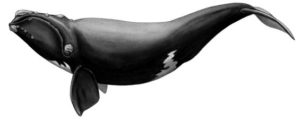
Eubalaena glacialis
EndangeredWhale
Threats
Collisions with vessels, entanglement in fishing gear and underwater noise are the most serious threats to the North Atlantic Right Whale population. In consequence of the 17 Right Whale Deaths of 2017 (approximately 4% of their entire population), the Department of Fisheries and Oceans (DFO) have implemented recovery actions to prevent future anthropocentric deaths – a commitment of the Government of Canada’s Oceans Protection Plan.
How you can help
-
Reduce plastic use – as baleen whales, such as Right Whales feed, they filter out water and ingest prey and oftentimes plastic. Plastic and other debris can not be naturally expelled from the body, filling its belly, mimicking that it is “full” and oftentimes will cause starvation and death.
-
Ensure all fishing gear are not discarded at sea, as fishing lines, gears, ropes, nets, can cause entanglement in whales. Entanglement can cause harm to the body resulting in sores and infection, and can also become too heavy and the whale does not have enough energy, causing drowning.
-
If you see an entangled whale call Whale Release and Strandings at 1-888-895-3003
Wolffish
The surrounding waters of Newfoundland and Labrador are home to three of four species of Wolffish: Atlantic (Striped), Spotted, and Northern. All three species have overlapping habitats and similar threats so they are combined when determining their recovery strategy. Wolffish species are ecologically important as their primary diet is sea urchins (though also includes brittlestars, crab, shrimp, and other crustaceans). A decrease in wolffish population therefore can attribute to an increase in sea urchins, which poses a threat to the entire ecosystem as over abundance of sea urchins can result in an “urchin barren”. Sea urchins feed on kelp and seaweed, large masses of urchins can forage entire kelp beds, removing habitat for breeding, recruitment and hiding areas for young from predators. Urchin barrens affect all species, including commercially important species such as cod, lobster, and crab.
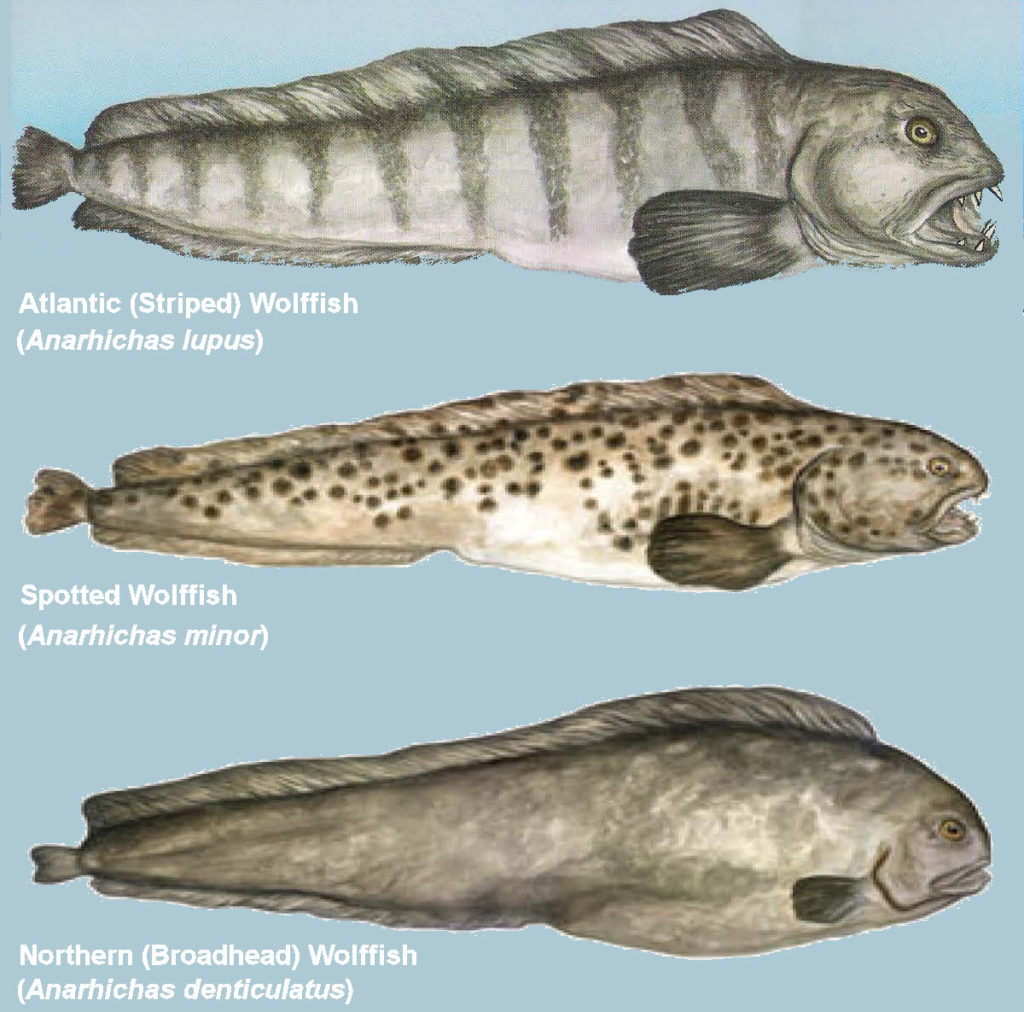
Know your wolfish
The Atlantic Wolffish is the most abundant of the three species found throughout the province, they are also commonly found both inshore and offshore unlike the other two species which predominately remain offshore. The head is large relative to the body, with vertical stripes on fins and body. Juveniles are yellowish brown with olive green fins, and adults range from yellowish brown to slate/purplish blue. Flesh is firm.
Northern Wolffish is commonly found the most offshore than the other two species. The head is small relative to the body. Pectoral fins and gill openings are also small. The body colour is more uniform for all sizes, ranging from dark grey to dark brown to purplish black. Indistinct dark spots are possible, but rare. Flesh is jelly-like.
Spotted Wolffish’s head is large relative to the body, with dark spots on fins and body. Juveniles are greyish brown (sometimes with a purplish colour), and adults range from yellowish brown to greyish brown to dark brown. Flesh is firm.
Spotted Wolffish (Anarhichas minor) , Northern Wolffish (Anarhichas denticulatus), Atlantic (Striped) Wolffish (Anarchichas lupus)
Threatened
Threats
The leading cause of Wolffish decline is suggested to be incidental bycatch during fishery activities (food, small and large scale, and inshore and offshore fisheries). However, there are other factors which contribute to their population decline such as poor recruitment do to climate change, habitat alterations and habitat destruction, pollution (ocean dumping and coastal run-off), seismic activities, and natural mortality due to parasites, disease and predation.
How you can help
What You Can Do To Help Wolffish Populations
-
Since 2004, all Wolffish accidentally caught during any fisheries must be released, quickly, without harm to the Wolffish, and at the site of capture.
-
Report any sighting of Wolffish to DFO or CPAWS-NL
-
Reduce plastic use and ensure plastic and other garbage are properly disposed of or recycled. Marine debris alters habitats and disrupts food chains, habitat conditions, and ultimately affects population success.




